A look at the forthcoming equipment for the British Army.
(Also my RAF and Army pages now have pictures!)
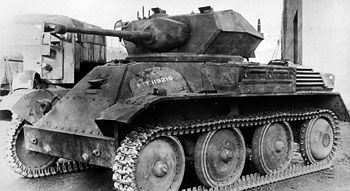
Light Tank Mk VII (A21): Modified Mk VI with sloped armour, new turret armed with a 2pdr gun and co-axial MG and hydraulically assisted steering. Designed in 1940 by Vickers the Mk VII is powered by a 148hp Meadows petrol engine for a top speed of 30mph and 125 mile road radius. Armour is 38-6mm thick and three crewmen are carried. 150 were ordered in early 1941 and production was handed to Metropolitan-Cammell.
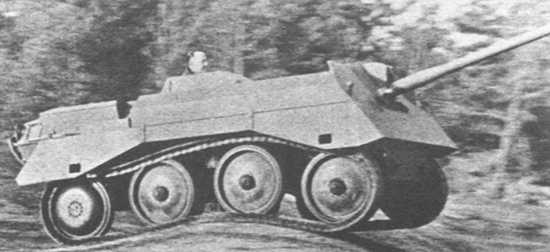
Alecto (A22): a mobile anti-tank gun with a 6pdr gun mounted low in a Mk VII hull with an open top. Four crewmen are carried and the engine and armour is unchanged. The Alecto II is armed with the new Ordnance 3.7in Mortar QF Mk II (95mm Howitzer) and the Alecto III will be armed with the 25pdr field gun. In early 1941 orders were placed for both the Alecto I and II. The Alecto II will not enter production until 1942.
Crusader I AA Mk II (1941): Twin 20mm Orkileon in enclosed turret with 25-15mm armour and stabilised sights
Crusader I ARV (1941): Modified tank with turret removed, demountable A-frame jib and winch in turret space
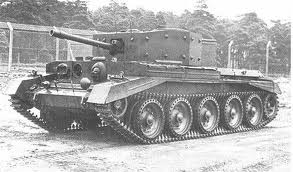
Cruiser Tank Mk VII Centaur (A19): Improved Crusader with bigger turret ring (for guns up to 75mm) and new turret and thicker armour with a Thornycroft RY14 500hp engine. Fitted with 6pdr Mk IV with a muzzle brake and 95mm howitzer (mod 3.7in) in the CS variant; designed 1940 by Leyland as interim Cromwell type. Production of 250 Centaur tanks was undertaken by Leyland during 1941-42. Armour is 76-20mm; dimensions 20ft 10ins long, 10ft wide, 8ft 2ins high; battle weight 63,300lbs; maximum speed 30mph and 18mph cross-country and a road radius 165 miles. Fording depth is 3ft; vertical obstacle 3ft and trench crossing 7ft 6ins.
Cruiser Tank Mk VIII Cromwell (A20): Design work begins in 1941 by Leyland and CC&F.
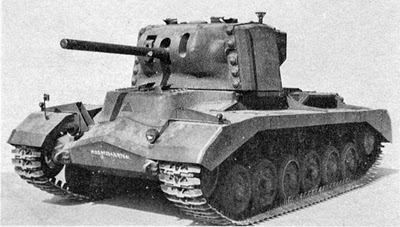
Infantry Tank Mk III Valiant (A24): designed by Vickers in 1941 as an improved Valentine with cast sections, new turret with 95mm howitzer or 6pdr gun, AEC diesel engines in prototypes. Armour is 114-10mm; dimensions 17ft 7ins long, 9ft 3ins wide, 7ft high; battle weight 60,480lbs; maximum speed 18mph and 8mph cross-country and a road radius 85 miles. Fording depth is 3ft; vertical obstacle 2ft 9ins and trench crossing 7ft 6ins.
Ordnance BL 5.5in Gun Mk III, Weight in action is 12,768lbs, shell weight 100lb (there is a lightweight 80lb shell), muzzle velocity is 1,675fps and maximum range is 16,200 yards. The carriage has 60 degrees of traverse and 40 degrees of elevation. Shell types are HE, concrete-piercing, fletchette, smoke and illumination. Under development from 1939 and entry into service planned for 1941.
Ordnance QF 3.7in Mk IV with totally new ancillary equipment, automatic fuze setter and automatic loader.
Ordnance QF 6pdr Mk VII with an improved mounting
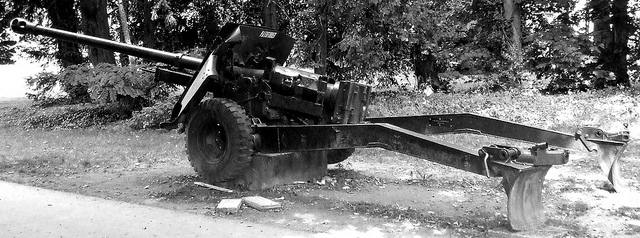
Ordnance 17pdr QF Mk II: Calibre 77mm, weight of shot 17lbs (AP, APC, APCBC, HE), muzzle velocity 2,600fps and penetration 131mm at 1000 yards. Weight in action is 2,605lbs; traverse is 90 degrees and elevation -5 to +15 degrees. Under development from May 1940 as a towed version of the Ordnance 17pdr QF Mk I tank gun for RA units. Service entry due late 1941.
.280 Rifle No.5 Mk III; after trials during 1938-39 the Army has chosen the Enfield Lock .280 7mm cartridge and the Vickers Rifle No.5 Mk I. The rifle will be refined and will use the .280 cartridge and will enter production during 1941 as the Rifle No.5 Mk III.







Quoted
Originally posted by Hood

